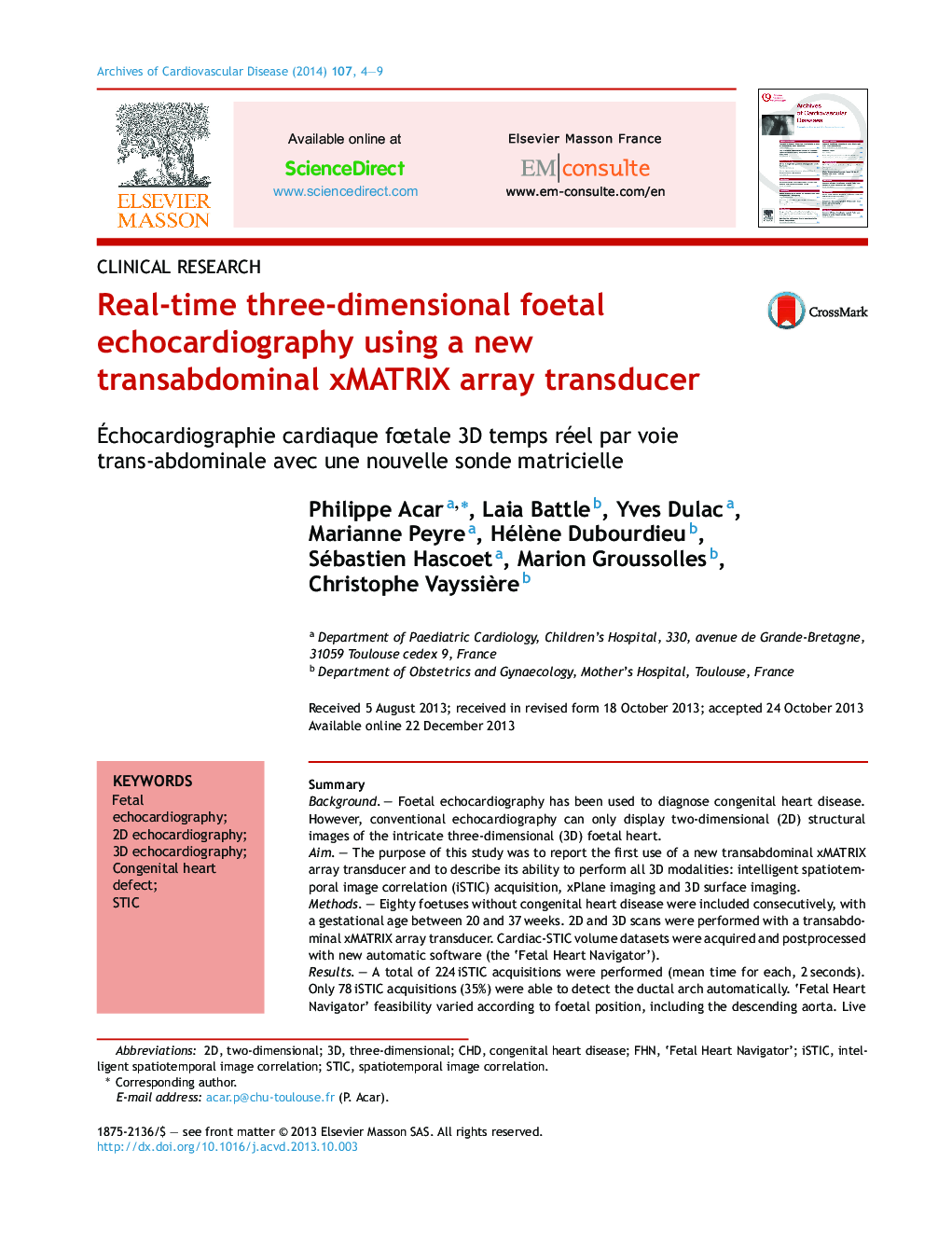| Article ID | Journal | Published Year | Pages | File Type |
|---|---|---|---|---|
| 2888891 | Archives of Cardiovascular Diseases | 2014 | 6 Pages |
SummaryBackgroundFoetal echocardiography has been used to diagnose congenital heart disease. However, conventional echocardiography can only display two-dimensional (2D) structural images of the intricate three-dimensional (3D) foetal heart.AimThe purpose of this study was to report the first use of a new transabdominal xMATRIX array transducer and to describe its ability to perform all 3D modalities: intelligent spatiotemporal image correlation (iSTIC) acquisition, xPlane imaging and 3D surface imaging.MethodsEighty foetuses without congenital heart disease were included consecutively, with a gestational age between 20 and 37 weeks. 2D and 3D scans were performed with a transabdominal xMATRIX array transducer. Cardiac-STIC volume datasets were acquired and postprocessed with new automatic software (the ‘Fetal Heart Navigator’).ResultsA total of 224 iSTIC acquisitions were performed (mean time for each, 2 seconds). Only 78 iSTIC acquisitions (35%) were able to detect the ductal arch automatically. ‘Fetal Heart Navigator’ feasibility varied according to foetal position, including the descending aorta. Live xPlane imaging had excellent feasibility regardless of foetal position; using rotation, lateral and vertical tilts, all cardiac structures were identified from a unique reference plane. Live 3D surface imaging had variable feasibility depending on the target structure. Only 10% of the volume dataset offered comprehensive imaging of intracardiac views.ConclusionThe new xMATRIX transabdominal transducer allows a multimodality approach to the foetal heart. Further studies that include foetuses with cardiac malformations are required.
RésuméContexteL’échocardiographie fœtale permet de dépister les malformations cardiaques chez le fœtus. Néanmoins, les ultrasons conventionnels sont limités à des coupes 2D.ObjectifNotre but a été de rapporter la 1re utilisation d’une sonde matricielle 3D transabdominale chez le fœtus.MéthodesQuatre-vingt fœtus sans malformations cardiaque d’âge gestationnel de 20 à 37 semaines d’aménorrhée ont été inclus incluant des acquisitions 2D et 3D (iSTIC, xPlan et imagerie de surface 3D). Un nouveau processeur automatique des données STIC (fetal heart navigator) a été utilisé.RésultatsDeux cent vingt-quatre acquisitions iSTIC ont été réalisées (temps moyen de deux secondes). Seulement 78 acquisitions iSTIC (35 %) ont été exploitables par le fetal heart navigator (nécessité d’inclure l’aorte descendante). Le xPlan avait une bonne faisabilité indépendante de la position du fœtus. À partir d’une image de référence, après rotation ou inclinaison latérale et verticale tilts, toutes les structures cardiaques ont pu être identifiées. L’imagerie de surface 3D n’a donné une image exploitable que dans 10 % des fœtus.ConclusionLa nouvelle sonde matricielle xMATRIX transabdominale permet une approche multimodale du cœur fœtal. D’autres études sont nécessaires pour démontrer son intérêt dans le dépistage des malformations cardiaques.
